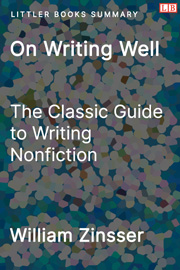Book Description
A timeless guide that teaches readers to write clear, concise, and compelling nonfiction.
If You Just Remember One Thing
Coming soon.
Bullet Point Summary and Quotes
- The secret to writing well is to write simply. Many writers make the mistake of trying to impress with complex language, resulting in difficult-to-read writing. Instead, writers should strive for simplicity by stripping down sentences to their core components and removing any unnecessary words or phrases.
- Clear writing requires clear thinking. Writers must always ask themselves what exactly they are trying to say and ruthlessly remove any clutter from their writing, including redundant prepositions (“face up to a challenge” to “face a challenge”), adjectives (“my personal experience” to “my experience”), and long words (“utilize” to “use”, “at present time” to “now”).
- The key to writing with style is to find your authentic voice. In other words, be yourself.
- To develop your style, start by writing and don't stress about the first few paragraphs. Relax, and reach for words that feel right to you, then you'll begin to find your natural flow and unique style.
- Writing in the first person can help you sound more natural and less stilted. Cultivate your natural voice in your writing process and your style will soon reveal itself.
- Be meticulous in choosing your words. Avoid clichés, use the thesaurus (but ensure the words accurately convey what you mean -- precision is more important than variety), don't use jargon and neologisms (new words) unless the context calls for them, and heed the rhythm and aural qualities of your sentences.
- Keep your writing focused and consistent. Do not shift the tone, voice, tense, or perspective.
- Answering the following questions can help you to remain focused and consistent:
- Who is your audience (e.g., general, niche, one person)?
- What style of writing will you use (e.g., formal, casual, humorous)?
- What is the point you're trying to make?
- The beginning and ending of a written piece are crucial in engaging the reader. The opening should be captivating and show the reader what's in it for them.
- An example from the author: “I've often wondered what goes into a hot dog. Now I know and I wish I didn't.”
- When concluding your writing, avoid unnecessary summarization and strive for brevity once you've conveyed your message.
- The foundation of good writing comes from practice and attention to established principles. Some of them are:
- Use active voice instead of passive voice (“he drove the car” vs “the car was driven by him”).
- Use precise verbs (“he lumbered” vs “he walked”).
- Avoid qualifiers (“she's very happy” vs “she's ecstatic”).
- Use adverbs cautiously (“she whispered” vs “she talked quietly”).
- Use adjectives cautiously (“giant” vs “tall giant”).
- It's okay to start a sentence with “but” or “yet” to signal a transition.
- Adverbs and adjectives become more powerful if you minimize their usage.
- Great writing comes from writers who are passionate about reading and writing. Instill in yourself a love for the craft by following your interests, writing regularly, and persevering through challenges.
- Your ideas come from your experiences. Live a rich life and you will have endless interesting things to write about.
- Focus on the writing process rather than the finished product. The final product will always be different from what you'd imagined at the start. Fixating on the end result can hinder the evolution of the story. It is important to refine and experiment with the story to find its potential. The process of writing is just as important as the final product.
On Writing Well: Resources
- Download this summary and 173+ other top nonfiction book summaries in one book (PDF, eBook, DOCX)
- Buy the book
